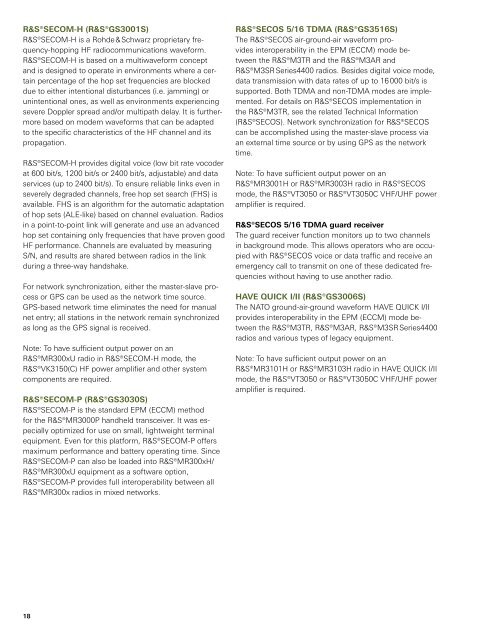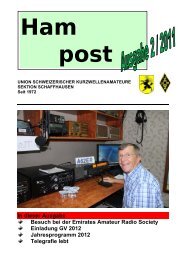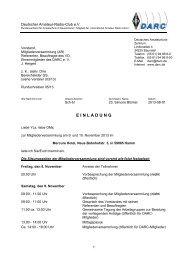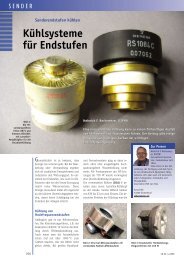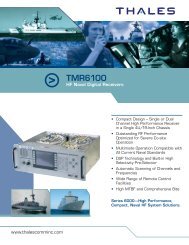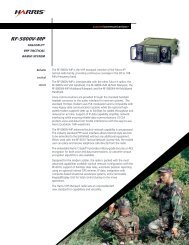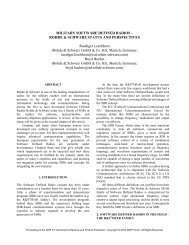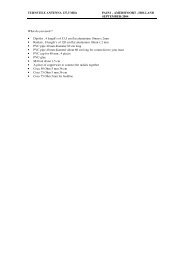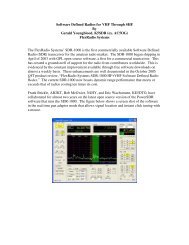Rohde & Schwarz M3TR - QSLNET.de
Rohde & Schwarz M3TR - QSLNET.de
Rohde & Schwarz M3TR - QSLNET.de
Create successful ePaper yourself
Turn your PDF publications into a flip-book with our unique Google optimized e-Paper software.
R&S®SECOM-H (R&S®GS3001S)<br />
R&S®SECOM-H is a <strong>Roh<strong>de</strong></strong> & <strong>Schwarz</strong> proprietary frequency-hopping<br />
HF radiocommunications waveform.<br />
R&S®SECOM-H is based on a multiwaveform concept<br />
and is <strong>de</strong>signed to operate in environments where a certain<br />
percentage of the hop set frequencies are blocked<br />
due to either intentional disturbances (i.e. jamming) or<br />
unintentional ones, as well as environments experiencing<br />
severe Doppler spread and/or multipath <strong>de</strong>lay. It is furthermore<br />
based on mo<strong>de</strong>m waveforms that can be adapted<br />
to the specific characteristics of the HF channel and its<br />
propagation.<br />
R&S®SECOM-H provi<strong>de</strong>s digital voice (low bit rate voco<strong>de</strong>r<br />
at 600 bit/s, 1200 bit/s or 2400 bit/s, adjustable) and data<br />
services (up to 2400 bit/s). To ensure reliable links even in<br />
severely <strong>de</strong>gra<strong>de</strong>d channels, free hop set search (FHS) is<br />
available. FHS is an algorithm for the automatic adaptation<br />
of hop sets (ALE-like) based on channel evaluation. Radios<br />
in a point-to-point link will generate and use an advanced<br />
hop set containing only frequencies that have proven good<br />
HF performance. Channels are evaluated by measuring<br />
S/N, and results are shared between radios in the link<br />
during a three-way handshake.<br />
For network synchronization, either the master-slave process<br />
or GPS can be used as the network time source.<br />
GPS-based network time eliminates the need for manual<br />
net entry; all stations in the network remain synchronized<br />
as long as the GPS signal is received.<br />
Note: To have sufficient output power on an<br />
R&S®MR300xU radio in R&S®SECOM-H mo<strong>de</strong>, the<br />
R&S®VK3150(C) HF power amplifier and other system<br />
components are required.<br />
R&S®SECOM-P (R&S®GS3030S)<br />
R&S®SECOM-P is the standard EPM (ECCM) method<br />
for the R&S®MR3000P handheld transceiver. It was especially<br />
optimized for use on small, lightweight terminal<br />
equipment. Even for this platform, R&S®SECOM-P offers<br />
maximum performance and battery operating time. Since<br />
R&S®SECOM-P can also be loa<strong>de</strong>d into R&S®MR300xH/<br />
R&S®MR300xU equipment as a software option,<br />
R&S®SECOM-P provi<strong>de</strong>s full interoperability between all<br />
R&S®MR300x radios in mixed networks.<br />
R&S®SECOS 5/16 TDMA (R&S®GS3516S)<br />
The R&S®SECOS air-ground-air waveform provi<strong>de</strong>s<br />
interoperability in the EPM (ECCM) mo<strong>de</strong> between<br />
the R&S®<strong>M3TR</strong> and the R&S®M3AR and<br />
R&S®M3SR Series4400 radios. Besi<strong>de</strong>s digital voice mo<strong>de</strong>,<br />
data transmission with data rates of up to 16 000 bit/s is<br />
supported. Both TDMA and non-TDMA mo<strong>de</strong>s are implemented.<br />
For <strong>de</strong>tails on R&S®SECOS implementation in<br />
the R&S®<strong>M3TR</strong>, see the related Technical Information<br />
(R&S®SECOS). Network synchronization for R&S®SECOS<br />
can be accomplished using the master-slave process via<br />
an external time source or by using GPS as the network<br />
time.<br />
Note: To have sufficient output power on an<br />
R&S®MR3001H or R&S®MR3003H radio in R&S®SECOS<br />
mo<strong>de</strong>, the R&S®VT3050 or R&S®VT3050C VHF/UHF power<br />
amplifier is required.<br />
R&S®SECOS 5/16 TDMA guard receiver<br />
The guard receiver function monitors up to two channels<br />
in background mo<strong>de</strong>. This allows operators who are occupied<br />
with R&S®SECOS voice or data traffic and receive an<br />
emergency call to transmit on one of these <strong>de</strong>dicated frequencies<br />
without having to use another radio.<br />
HAVE QUICK I/II (R&S®GS3006S)<br />
The NATO ground-air-ground waveform HAVE QUICK I/II<br />
provi<strong>de</strong>s interoperability in the EPM (ECCM) mo<strong>de</strong> between<br />
the R&S®<strong>M3TR</strong>, R&S®M3AR, R&S®M3SR Series4400<br />
radios and various types of legacy equipment.<br />
Note: To have sufficient output power on an<br />
R&S®MR3101H or R&S®MR3103H radio in HAVE QUICK I/II<br />
mo<strong>de</strong>, the R&S®VT3050 or R&S®VT3050C VHF/UHF power<br />
amplifier is required.<br />
18


